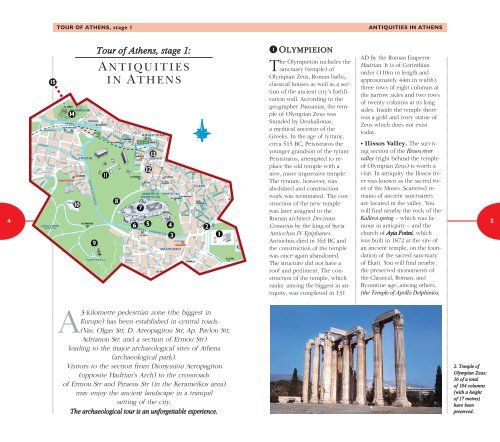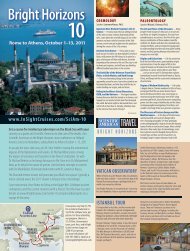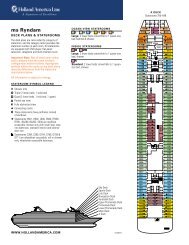HERE - Olympia Summer Academy
HERE - Olympia Summer Academy
HERE - Olympia Summer Academy
You also want an ePaper? Increase the reach of your titles
YUMPU automatically turns print PDFs into web optimized ePapers that Google loves.
TOUR OF ATHENS, stage 1<br />
ANTIQUITIES IN ATHENS<br />
4<br />
15<br />
14<br />
Tour of Athens, stage 1:<br />
Α NTIQUITIES<br />
IN Α THENS<br />
13<br />
1 ΟLYMPIEION<br />
The Olympieion includes the<br />
sanctuary (temple) of<br />
<strong>Olympia</strong>n Zeus, Roman baths,<br />
classical houses as well as a section<br />
of the ancient city’s fortification<br />
wall. According to the<br />
geographer Pausanias, the temple<br />
of <strong>Olympia</strong>n Zeus was<br />
founded by Deukalionas,<br />
a mythical ancestor of the<br />
Greeks. In the age of tyrrany,<br />
circa 515 BC, Peisistratos the<br />
younger grandson of the tyrant<br />
Peisistratos, attempted to replace<br />
the old temple with a<br />
new, more impressive temple.<br />
The tyranny, however, was<br />
abolished and construction<br />
work was terminated. The construction<br />
of the new temple<br />
was later assigned to the<br />
Roman architect Decimus<br />
Cossutius by the king of Syria<br />
Antiochus IV Epiphanes.<br />
Antiochus died in 163 BC and<br />
the construction of the temple<br />
was once again abandoned.<br />
The structure did not have a<br />
roof and pediment. The construction<br />
of the temple, which<br />
ranks among the biggest in antiquity,<br />
was completed in 131<br />
AD by the Roman Empe ror<br />
Hadrian. It is of Corinthian<br />
order (110m in length and<br />
approximately 44m in width),<br />
three rows of eight columns at<br />
the narrow sides and two rows<br />
of twenty columns at its long<br />
sides. Inside the temple there<br />
was a gold and ivory statue of<br />
Zeus which does not exist<br />
today.<br />
• Ilissos Valley. The surviving<br />
section of the Ilissos river<br />
valley (right behind the temple<br />
of <strong>Olympia</strong>n Zeus) is worth a<br />
visit. In antiquity the Ilissos river<br />
was known as the sacred river<br />
of the Muses. Scattered remains<br />
of ancient sanctuaries<br />
are located in the valley. You<br />
will find nearby the rock of the<br />
Kalliroi spring – which was famous<br />
in antiquity – and the<br />
church of Ayia Fotini, which<br />
was built in 1872 at the site of<br />
an ancient temple, on the foundation<br />
of the sacred sanctuary<br />
of Ekati. You will find nearby,<br />
the preserved monuments of<br />
the Classical, Roman, and<br />
Byzantine age, among others,<br />
(the Temple of Apollo Delphinios,<br />
5<br />
A3-kilometre pedestrian zone (the biggest in<br />
Europe) has been established in central roads<br />
(Vas. Olgas Str, D. Areopagitou Str, Ap. Pavlou Str,<br />
Adrianou Str. and a section of Ermou Str)<br />
leading to the major archaeological sites of Athens<br />
(archaeological park).<br />
Visitors to the section from Dionyssiou Aeropagitou<br />
(opposite Hadrian’s Arch) to the crossroads<br />
of Ermou Str and Piraeus Str (in the Kerameikos area)<br />
may enjoy the ancient landscape in a tranquil<br />
setting of the city.<br />
The archaeological tour is an unforgettable experience.<br />
2. Temple of<br />
<strong>Olympia</strong>n Zeus:<br />
16 of a total<br />
of 104 columns<br />
(with a height<br />
of 17 metres)<br />
have been<br />
preserved.
















